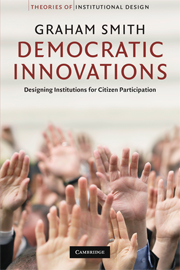Book contents
- Frontmatter
- Contents
- Acknowledgments
- Introduction
- 1 Studying democratic innovations: an analytical framework
- 2 Popular assemblies: from New England town meetings to participatory budgeting
- 3 Mini-publics: assemblies by random selection
- 4 Direct legislation: direct democracy through the ballot box
- 5 E-democracy: the promise of information and communication technology
- 6 Realising the goods of democratic institutions
- Conclusion
- References
- Index
5 - E-democracy: the promise of information and communication technology
Published online by Cambridge University Press: 19 January 2010
- Frontmatter
- Contents
- Acknowledgments
- Introduction
- 1 Studying democratic innovations: an analytical framework
- 2 Popular assemblies: from New England town meetings to participatory budgeting
- 3 Mini-publics: assemblies by random selection
- 4 Direct legislation: direct democracy through the ballot box
- 5 E-democracy: the promise of information and communication technology
- 6 Realising the goods of democratic institutions
- Conclusion
- References
- Index
Summary
We are witnessing a quite extraordinary pace of change in information and communication technology (ICT), which is enabling ever more inventive forms of interconnection and communication between citizens across global space: with the ‘ubiquity of computer networks, new spaces for public discussion and exchange are invented, introduced, and updated on an almost continual basis’ (Sack 2005: 242). But given the pace of change, the political, social, economic and environmental impact of new technology is not easy to discern. Visions and scenarios of the impact of ICT on democratic governance differ widely. At one extreme, ICT represents the dawning of a new age for democracy, offering new opportunities for citizens to participate in local through to global public spheres and grassroots movements to challenge corporate dominance; at the other extreme, ICT leads to increased surveillance by the state and commercial actors and the further marginalization and fragmentation of politics in favour of highly personalised forms of entertainment (Barber 1998; Gibson et al. 2004; Kamarck and Nye Jr. 2002; Latham and Sassen 2005b; Sunstein 2001; Tsagarousianou et al. 1998). Arguably, however, the distance between rhetoric and reality is vast: ‘little empirical research has been done on the claims of either supporters or critics of e-democracy, or the specific practices with which democracy is being brought into the public sphere’ (Schlosberg et al. 2006: 211). The jury remains out on the impact of ICT on democratic theory and practice.
- Type
- Chapter
- Information
- Democratic InnovationsDesigning Institutions for Citizen Participation, pp. 142 - 161Publisher: Cambridge University PressPrint publication year: 2009



